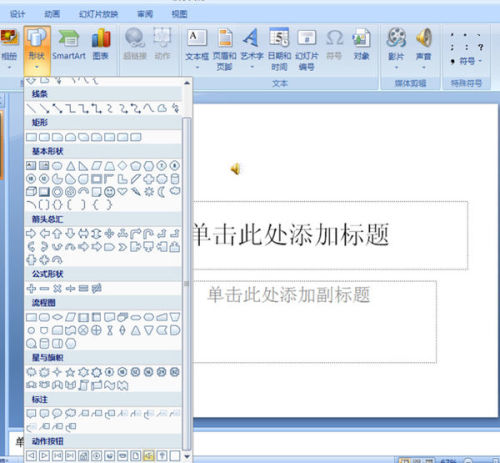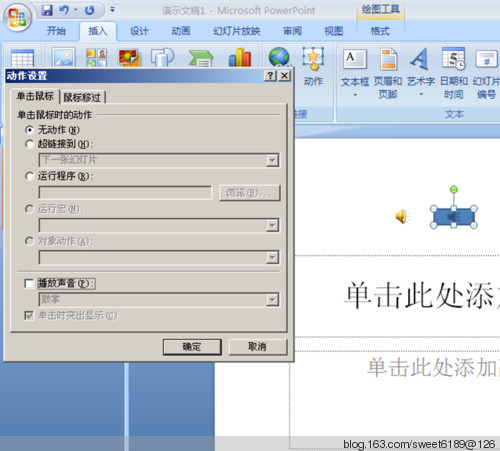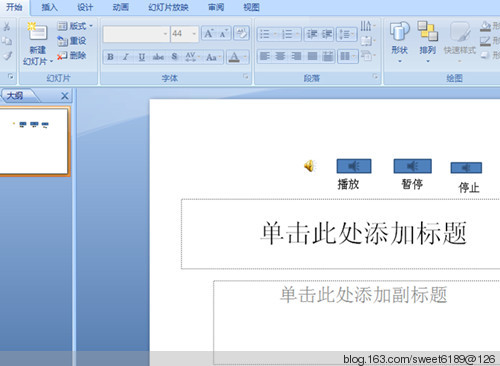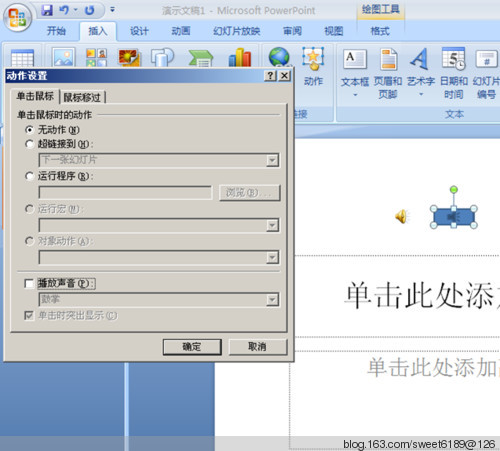 Software Tutorial
Software Tutorial
 Office Software
Office Software
 How to add background music buttons to PPT without causing the sound to disappear?
How to add background music buttons to PPT without causing the sound to disappear?
How to add background music buttons to PPT without causing the sound to disappear?
How to add background music to ppt without the sound disappearing when pressing keys
You use the arrow keys to flip the slides, right?
In fact, as long as there are no special settings, ordinary keys (except shortcut keys) will not affect the background music. However, if the settings are not in place, pressing the direction keys to turn the slides may cause the background music to stop. , briefly talk about how to make background music play on multiple slides.
If the music is not long enough, you can make the music play in a loop according to the following method (the following uses office xp as an example, other versions are for reference)
1. After inserting the sound, right-click the small speaker icon, then "Edit Sound Object" and select Loop Play Until Stop
2. Right-click the speaker icon again, select "Custom Animation...", and on the right, select "Effect Options". In the pop-up dialog box, there is an item to set the stop time. Using the third item "On Slide", you can set this number a little larger. Because this number refers to the total number of slides you actually show, not the number of slides contained in your ppt file (because if you use the arrow keys to turn back during the show, it will also be included in the total number of shows, that is, If a slide is shown repeatedly, the actual number of slides shown will be greater than the number of slides in the ppt file you created)
Regarding the issue of the number of slides above, there is a detailed description in the following article, you can refer to:
How to set the sound effect of the slide action button
1. Open a blank slide in the PowerPoint presentation, click the "Insert" tab, click the "Sound" button in the "Coal Clip" group, and click "File" in the pop-up drop-down menu. the sound of".
2. Assume that the Kugou Music folder is in "My Documents". In the pop-up "Insert Sound" dialog box, select a song in the Kugou Music folder and click "OK". Insert a slide, and a small speaker icon will appear on the slide. Click "On Click" in the pop-up dialog box. (Note: Do not click Auto.)
3. Click the "Shape" button in the "Insert" tab, a dialog box will pop up, pull down the slider, find the "Action Button" item, find and click "Sound Button" in "Action Button" , when the cursor is in the shape of a cross, hold down the left mouse button and draw a sound button icon, as shown below:

4. When you release the mouse, the "Action Settings" dialog box will pop up. Select "No Action" and cancel "Play Sound Applause", that is, cancel the √ in the "Play Sound" check box. Do not change other items in the dialog box. Click OK.

5. Repeat the previous step twice. Draw the second and third action button icons and arrange them from left to right. These three action button icons are automatically named Sound 3, Sound 4, and Sound 5 by the system from left to right. (hidden) (maybe other numbers sometimes, not necessarily 3,4,5).
6. Click "Horizontal Text Box" in "Text Box" under the "Insert" tab. When the cursor is in the shape of ↓, hold down the left mouse button and draw 3 characters under the 3 action buttons. A text box, enter the text "play", "pause" and "stop" from left to right, as shown below:

7. Click the "Custom Animation" button under the "Animation" tab.
8. Click the small speaker icon (that is, activate the small speaker icon), click the "Add Effects" drop-down arrow ▼ in the task pane on the right, and click "Sound Operation" in the pop-up drop-down menu. ⊿Play".
9. Click the mouse icon in the task pane (click the ▼ above the three words "Trigger") "⊿ Set Song" text box drop-down arrow ▼, click "Timing" in the drop-down menu ".
10. The "Play Sound" dialog box pops up, click "Trigger", select "Start the effect when the following objects are clicked", that is, let the radio button appear ⊙, click the drop-down arrow ▼, and click in the drop-down menu Click the "Set Song" action "Sound 5" and click "OK", as shown below:

11. Click the small speaker icon, click "Add Effect" in the task pane on the right, and click "II Pause" in "Sound Operation" in the pop-up drop-down menu.
12. Click the drop-down arrow ▼ of the "II Set Song" text box with the mouse icon in the task pane, click "Timing" in the drop-down menu, and the "Play Sound" dialog box will pop up, click "Trigger" , select "Start the effect when the following objects are clicked", that is, make the radio button appear ⊙, click the drop-down arrow, click "⊿Beautiful Girl Loves Angry" and "Sound 6" in the drop-down menu, and click "OK".
13. Click the small speaker icon, click "Add Effect" in the task pane on the right, and click "□ Stop" in "Sound Operation" in the pop-up drop-down menu.
14. Click the drop-down arrow ▼ of the "□Set Song" text box with the mouse icon in the task pane, click "Timing" in the drop-down menu, the "Play Sound" dialog box will pop up, click "Trigger" , select "Start the effect when the following objects are clicked", that is, let the radio button appear ⊙, click the drop-down arrow ▼, click "⊿Beautiful girl loves to be angry" and "Sound 7" in the drop-down menu, click "OK" .
15. After the above settings, the three buttons "play", "pause" and "stop" are set.
16. Click the "Slideshow" tab, click "Start from the beginning" to show the slideshow.
17. During the slide show, when you click the "Play" button, the sound will be played. When you click the "Pause" button, the playback will be paused. Click the "Pause" button again and the sound will be played again. Click the "Stop" button. to stop playback. You can also delete the "play" button and "stop" button and replace the "play" button and "stop" button with a "pause" button. If you delete the "Play" button and the "Stop" button, you need to rename the "Pause" button to "Play/Pause".
The above is the detailed content of How to add background music buttons to PPT without causing the sound to disappear?. For more information, please follow other related articles on the PHP Chinese website!

Hot AI Tools

Undresser.AI Undress
AI-powered app for creating realistic nude photos

AI Clothes Remover
Online AI tool for removing clothes from photos.

Undress AI Tool
Undress images for free

Clothoff.io
AI clothes remover

AI Hentai Generator
Generate AI Hentai for free.

Hot Article

Hot Tools

Notepad++7.3.1
Easy-to-use and free code editor

SublimeText3 Chinese version
Chinese version, very easy to use

Zend Studio 13.0.1
Powerful PHP integrated development environment

Dreamweaver CS6
Visual web development tools

SublimeText3 Mac version
God-level code editing software (SublimeText3)

Hot Topics
 1377
1377
 52
52
 5 Things You Can Do in Excel for the Web Today That You Couldn't 12 Months Ago
Mar 22, 2025 am 03:03 AM
5 Things You Can Do in Excel for the Web Today That You Couldn't 12 Months Ago
Mar 22, 2025 am 03:03 AM
Excel web version features enhancements to improve efficiency! While Excel desktop version is more powerful, the web version has also been significantly improved over the past year. This article will focus on five key improvements: Easily insert rows and columns: In Excel web, just hover over the row or column header and click the " " sign that appears to insert a new row or column. There is no need to use the confusing right-click menu "insert" function anymore. This method is faster, and newly inserted rows or columns inherit the format of adjacent cells. Export as CSV files: Excel now supports exporting worksheets as CSV files for easy data transfer and compatibility with other software. Click "File" > "Export"
 How to Use LAMBDA in Excel to Create Your Own Functions
Mar 21, 2025 am 03:08 AM
How to Use LAMBDA in Excel to Create Your Own Functions
Mar 21, 2025 am 03:08 AM
Excel's LAMBDA Functions: An easy guide to creating custom functions Before Excel introduced the LAMBDA function, creating a custom function requires VBA or macro. Now, with LAMBDA, you can easily implement it using the familiar Excel syntax. This guide will guide you step by step how to use the LAMBDA function. It is recommended that you read the parts of this guide in order, first understand the grammar and simple examples, and then learn practical applications. The LAMBDA function is available for Microsoft 365 (Windows and Mac), Excel 2024 (Windows and Mac), and Excel for the web. E
 If You Don't Use Excel's Hidden Camera Tool, You're Missing a Trick
Mar 25, 2025 am 02:48 AM
If You Don't Use Excel's Hidden Camera Tool, You're Missing a Trick
Mar 25, 2025 am 02:48 AM
Quick Links Why Use the Camera Tool?
 How to Create a Timeline Filter in Excel
Apr 03, 2025 am 03:51 AM
How to Create a Timeline Filter in Excel
Apr 03, 2025 am 03:51 AM
In Excel, using the timeline filter can display data by time period more efficiently, which is more convenient than using the filter button. The Timeline is a dynamic filtering option that allows you to quickly display data for a single date, month, quarter, or year. Step 1: Convert data to pivot table First, convert the original Excel data into a pivot table. Select any cell in the data table (formatted or not) and click PivotTable on the Insert tab of the ribbon. Related: How to Create Pivot Tables in Microsoft Excel Don't be intimidated by the pivot table! We will teach you basic skills that you can master in minutes. Related Articles In the dialog box, make sure the entire data range is selected (
 Microsoft Excel Keyboard Shortcuts: Printable Cheat Sheet
Mar 14, 2025 am 12:06 AM
Microsoft Excel Keyboard Shortcuts: Printable Cheat Sheet
Mar 14, 2025 am 12:06 AM
Master Microsoft Excel with these essential keyboard shortcuts! This cheat sheet provides quick access to the most frequently used commands, saving you valuable time and effort. It covers essential key combinations, Paste Special functions, workboo
 Use the PERCENTOF Function to Simplify Percentage Calculations in Excel
Mar 27, 2025 am 03:03 AM
Use the PERCENTOF Function to Simplify Percentage Calculations in Excel
Mar 27, 2025 am 03:03 AM
Excel's PERCENTOF function: Easily calculate the proportion of data subsets Excel's PERCENTOF function can quickly calculate the proportion of data subsets in the entire data set, avoiding the hassle of creating complex formulas. PERCENTOF function syntax The PERCENTOF function has two parameters: =PERCENTOF(a,b) in: a (required) is a subset of data that forms part of the entire data set; b (required) is the entire dataset. In other words, the PERCENTOF function calculates the percentage of the subset a to the total dataset b. Calculate the proportion of individual values using PERCENTOF The easiest way to use the PERCENTOF function is to calculate the single
 You Need to Know What the Hash Sign Does in Excel Formulas
Apr 08, 2025 am 12:55 AM
You Need to Know What the Hash Sign Does in Excel Formulas
Apr 08, 2025 am 12:55 AM
Excel Overflow Range Operator (#) enables formulas to be automatically adjusted to accommodate changes in overflow range size. This feature is only available for Microsoft 365 Excel for Windows or Mac. Common functions such as UNIQUE, COUNTIF, and SORTBY can be used in conjunction with overflow range operators to generate dynamic sortable lists. The pound sign (#) in the Excel formula is also called the overflow range operator, which instructs the program to consider all results in the overflow range. Therefore, even if the overflow range increases or decreases, the formula containing # will automatically reflect this change. How to list and sort unique values in Microsoft Excel
 How to Completely Hide an Excel Worksheet
Mar 31, 2025 pm 01:40 PM
How to Completely Hide an Excel Worksheet
Mar 31, 2025 pm 01:40 PM
Excel worksheets have three levels of visibility: visible, hidden, and very hidden. Setting the worksheet to "very hidden" reduces the likelihood that others can access them. To set the worksheet to "very hidden", set its visibility to "xlsSheetVeryHidden" in the VBA window. Excel worksheets have three levels of visibility: visible, hidden, and very hidden. Many people know how to hide and unhide the worksheet by right-clicking on the tab area at the bottom of the workbook, but this is just a medium way to remove the Excel worksheet from the view. Whether you want to organize the workbook tabs, set up dedicated worksheets for drop-down list options and other controls, keeping only the most important worksheets visible, and



